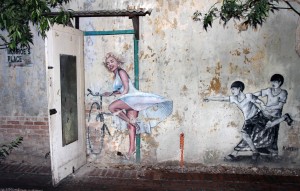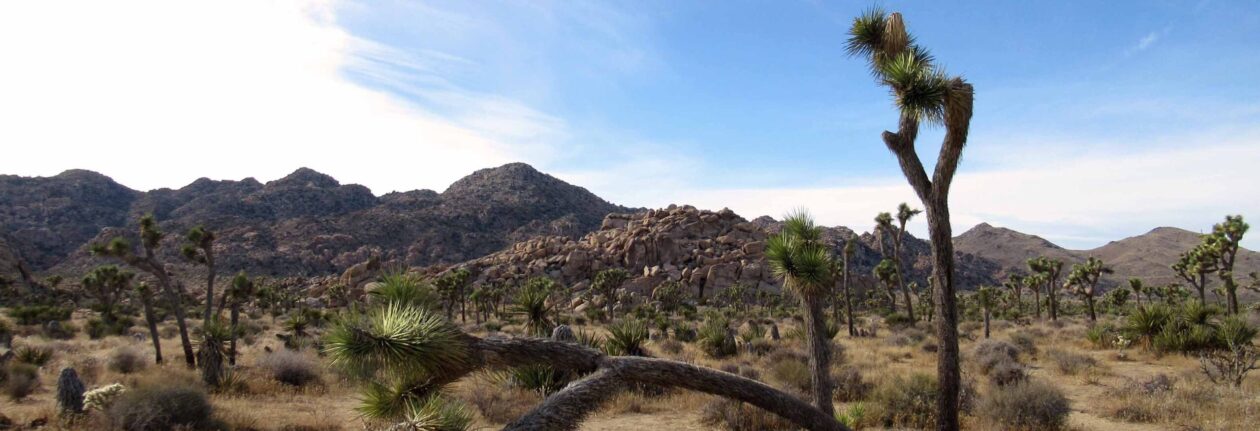Ipoh, Malaysia
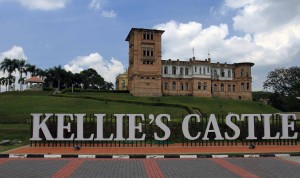
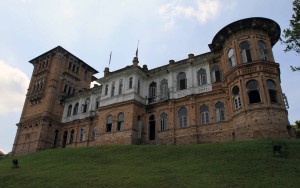
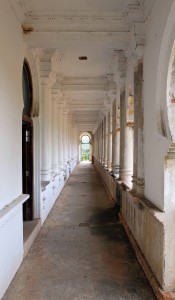
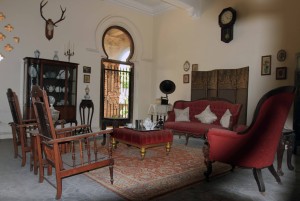
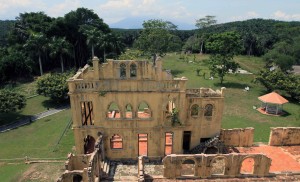
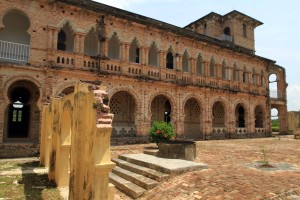
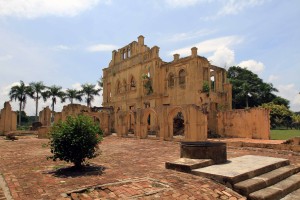
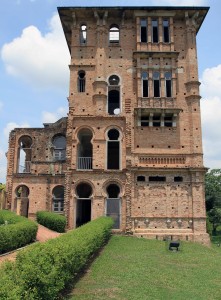
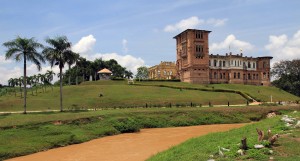
Got up today and decided to first travel to Kellie’s Castle. I took a taxi from the hotel and once we got on to the road, the taxi driver took a swig of liquor from the bottle resting beside him; then we passed a police checkpoint (one of those bullshit government nanny operations designed to ensure everyone is wearing their seat-belts, but really used to collect revenue); after making it through the checkpoint, the taxi driver immediately unbuckled his seat-belt (see? – bullshit!); we drove south to Kellie’s Castle and after about twenty minutes arrived at the entrance; I paid the flat fare (unfortunately all the taxis in Ipoh charge a flat fare – no meters here – and the castle, as well as some other attractions in Ipoh, are too far for city public buses to travel to) and then paid the entrance fee. Kellie’s Castle (also known as “Kellie’s Folly”) was built by a Scottish planter named William Kellie Smith; he initially built his first mansion, named “Kellas House” (a modest wooden bungalow which no longer exists); then, with the birth of his son, he started planning and building his second mansion; first, a brick extension to his first house was built in 1909, then, in 1915, he began building his second extension, now known as “Kellie’s Castle” (which is the two-story imposing structure that first greets visitors and can be seen from the highway), which incorporated Scottish, Indian, and Moorish architecture; most of the castle was complete, but in 1926, William Kellie Smith died of pneumonia during a trip in Portugal; his wife then moved back to Scotland and the mansion was sold to a British company named “Harrisons and Crossfield”; then jungle overtook the mansion until it was made in to a museum; also, the mansion is supposedly haunted, though I witnessed no evidence of this during my visit. I first walked around the second, and last extension, the “castle”, going from the first floor, to the second, then to the rooftop, and up the tall tower, to its rooftop; I then walked back down the steps and visited the wine cellar (the secret tunnel in the cellar, which is speculated to have run to the Hindu temple located 500 meters away has been sealed by the museum authorities). After touring Kellie’s Castle, I then walked around outside viewing the first extension to “Kellas House”, which now stands with the help of added support beams and is in a more ruinous state than the “castle”. Then I proceeded to walk around the mansion grounds, passing by, and looking in to, some old structures that looks as though they were offices or rooms for rent (there were no signs to indicate their former purpose, but they were “newer looking” with a public toilet facility). Then after ensuring I had seen everything there was to see at Kellie’s Castle, I had the woman at the ticket counter call a taxi cab for me. It wasn’t long before the taxi had arrived and I was off to my next destination: Kek Lok Tong cave temple.
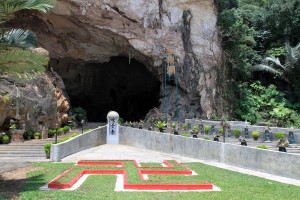
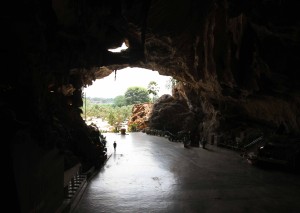
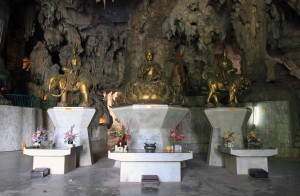
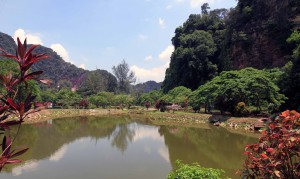
The taxi driver had managed to find Kek Lok Tong temple thanks to many signs showing the way; then he finally gave me his price, which was a bullshit foreigner price for the trip, so I talked him down some, which he quickly agreed to – probably meaning I paid too much. Fuck taxi drivers. I quickly exited his despicable presence and tried to remember that not all human beings are terrible people – just most. Then I walked to the turtle pond near the cave entrance and watched a man feed them snacks (throwing them in to the pond); as the turtles tried nibbling at the food, they kept hopelessly pushing the snacks away (except the really large turtles who had no problem eating the food) – another Malay man kept telling me it was as though they were playing water polo. Then I walked inside the cave temple and was greeted by many Buddhist and Taoist statues, as well as miniature statues of various animals and people. In the 1920s, it was used as a place of worship, then it became an iron mining site (enlarging the cave), until 1982, when it was given to a non-profit organization, which made it in to the temple it is today. I walked through the cavern and came out on the other side of the limestone mountain, where there were two ponds and gardens. Then, I tried to take a short cut to the next cave temple I wished to see today, but was denied access (due to the road being owned by a factory); so I walked back through the cave temple and then followed the signs (directing tourists to the Kek Lok Tong cave temple) in reverse. I then made it to the highway and walked south to where a cluster of temples are located on an access road.
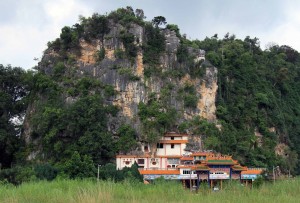
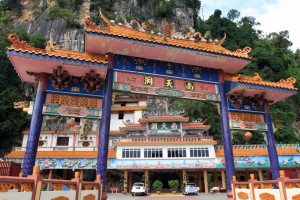
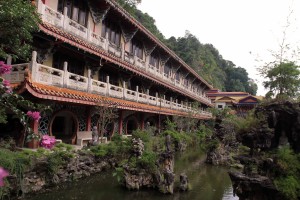
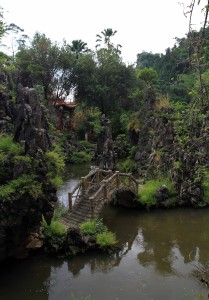
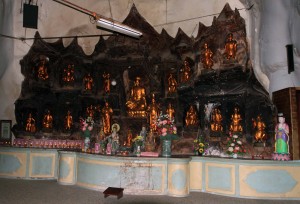
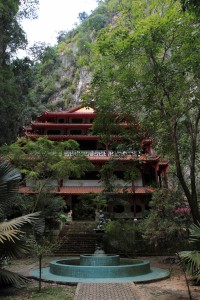
I walked down the access road, passing the Ling Sen Tong temple, then the Tokong Nam Thean Tong temple, before finally reaching the Sam Poh Tong temple (another cave temple, and the largest in Malaysia). Outside the cave, is a three-story building (done up in Chinese architecture) next to a rectangular pond with many slim, craggy rock formations hosting a variety of plants and figurines (a well maintained and beautiful garden); also, the pond has a square shaped shrine designed to look like a house boat at its southern end. The outside gardens were gorgeous to behold, and many of man’s best friends were outside the temple eager to greet anyone who might be willing to part with some sustenance or love. I then walked inside the grand temple where there were many places to pray and worship, with many Buddhist statues; then, proceeding through the temple, I came back outside, in to a large, natural hole in the limestone mountain; in this clearing was a multi-storied temple (closed to visitors), many statues and steles, and a tortoise pond. As I started to walk back inside the temple cave, a siren sounded and I was told the temple was closing for the day; so I was escorted out by an older woman and I walked back along the highway . . . for some time until I found a Starbucks to refresh me. Then I walked to a bus stop and rode the city’s public bus to the Ipoh Bus Station.
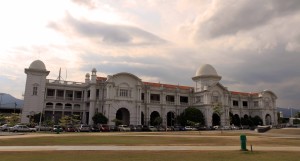
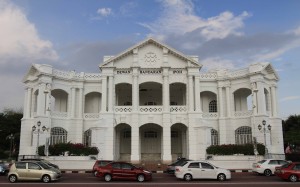
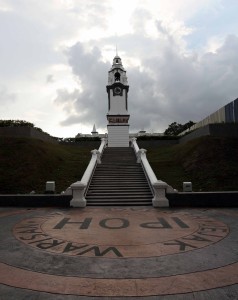
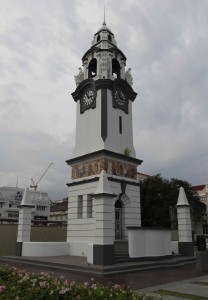
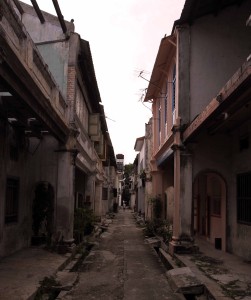
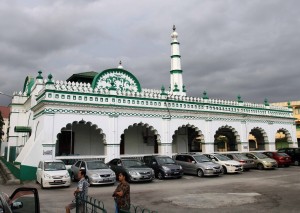
From the Ipoh Bus Station, I walked to the Ipoh Railway Station to admire the British colonial architecture and to see if they had any favorable tickets available to Butterworth Station (near my next stop in Malaysia: George Town) – they did not (the only trains available leave at 19:00 and 01:00). I then walked to the Old Town Hall and Post Office, located across the street from the Railway Station. From there I walked to the Birch Memorial, which is a clock tower built in 1909 and has four panels with 44 famous historical figures, designed to illustrate the growth of civilization. Then I walked around the old town, admiring many of the aged facades, some still standing strong, while others wither away from neglect. At this point the sky became poisonous and soon started to rain, but luckily it was light enough that it did not hinder my tour of the historic city. Throughout the old town, there were also many murals painted on walls by famous street artists (some were rather well done). I walked east, passing a number of old banks and even a man tossed from his motorbike, caused by a collision with a bus (thankfully the man was uninjured and able to get up from the pavement, though the food he was transporting on his bike lay wasted on the road); I then walked through Panglima Lane (also known as “Concubine Lane” – some people are only born with one talent, so they may as well use it), then by the Town Padang Mosque, St. Michael’s Institution, the Church of Saint John, and finally the Royal Ipoh Club (still an exclusive “member’s only” club to this day). After touring the historical city of Ipoh, I tried to find a place to eat dinner, but – much to my dismay – most restaurants in the city center, as well as beyond the center, close rather early in Ipoh, so I walked back to my hotel room and picked up snacks and beer along the way to give me my daily dose of calories. Then, after a long day of walking, I retired and fell asleep.
